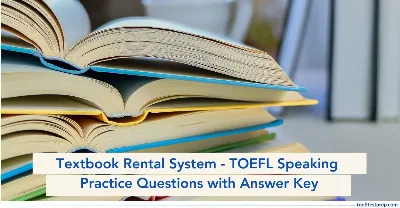The Significance of the Silk Road in Trade - TOEFL Listening Practice Test

"Prepare for the TOEFL Listening Section with a practice test on 'The Formation and Types of Coral Reefs' and learn the skills to improve your score in the TOEFL exam. "
Key Highlights
The TOEFL Listening segment is intended to evaluate how well you understand spoken English within an academic environment, particularly through lectures. This section features various listening passages that discuss topics such as literature, science, and social studies, followed by multiple-choice questions that assess your comprehension. Each lecture is designed to replicate actual classroom experiences, providing an opportunity for you to engage with complex ideas and themes.
To assist you in preparing effectively, we’ve created a listening practice set focused on "The Significance of the Silk Road in Trade." This set not only covers the historical and economic aspects of the Silk Road but also provides insights into its cultural impact.
As you listen, pay attention to key details and main ideas, as these will be crucial for answering the questions accurately. With consistent practice and a focused approach, you can boost your confidence and improve your performance in the TOEFL Listening section. Let’s begin this journey to deepen your understanding of the Silk Road and sharpen your listening abilities!
Listening Instructions
- You can listen to each conversation and lecture only once.
- You have approximately 8 minutes to listen to the conversation/lecture and respond to the questions.
- Each question generally carries one point unless otherwise specified in the instructions, which will explicitly state the assigned points for specific questions.
- After listening to the Conversation, respond to questions related to the topic based on explicit or implicit statements made by the speakers.
- Feel free to make notes as you listen. You can refer to your notes to aid in answering the questions.
- We recommend practicing note-taking with a pen and paper, similar to what you'll do during the TOEFL Exam.
Conversation on Master TOEFL Listening with the test
Now listen to the audio.

Questions
Directions: Mark your answer by selecting your choice.
Gist-Content Questions
- What is the main topic of the lecture?
- The history of European trade
- The significance of the Silk Road in trade and cultural exchange
- The impact of spices on global trade
- The role of merchants in ancient economies
Detail Questions
- According to the professor, what valuable commodities were transported along the Silk Road?
- Gold and silver
- Silk, spices, and precious metals
- Textiles and ceramics
- Fruits and vegetables
Function Questions
- What does the professor mean when he says, "The Silk Road was not merely a conduit for trade"?
- It was only used for transporting goods.
- It also facilitated cultural and technological exchanges.
- It was primarily a military route.
- It was a dangerous path for merchants.
Attitude Questions
- What is the professor's attitude towards the impact of the Silk Road on civilisations?
- Critical
- Indifferent
- Appreciative
- Pessimistic
Organization Questions
- Why does the professor mention scholars and travellers like Marco Polo?
- To highlight the dangers of travelling the Silk Road
- To illustrate the cultural exchange that occurred along the trade routes
- To discuss the economic benefits of trade
- To explain the geographical layout of the Silk Road
Connecting Content Questions
- What can be inferred about the legacy of the Silk Road in contemporary society?
- It has no relevance to modern trade.
- It continues to influence global trade and cultural interactions.
- It was a short-lived phenomenon with little impact.
- It primarily affected only Asian countries.
Transcript of the Audio Conversation on The Formation and Types of Coral Reefs
Today, we will explore the historical significance of the Silk Road, a vast network of trade routes that connected the East and West from approximately the 2nd century BCE to the 14th century CE. The primary aim of this lecture is to elucidate how the Silk Road facilitated not only the exchange of goods but also the transfer of culture, technology, and ideas across diverse civilisations.
Firstly, let us examine the economic impact of the Silk Road. This extensive network enabled merchants to transport valuable commodities such as silk, spices, and precious metals over considerable distances. For instance, silk, which was highly prized in Europe, was transported from China, while European goods, including glassware and wool, found their way to Asian markets. This exchange fostered economic interdependence among various civilisations, leading to the growth of thriving cities along the trade routes, such as Samarkand and Bukhara, which became bustling centres of commerce.
Moreover, the Silk Road played a crucial role in the dissemination of knowledge and culture. Scholars and travellers, such as Marco Polo, traversed these routes, sharing insights about different societies and their practices. This cultural exchange enriched the intellectual landscape of the time, introducing innovations such as papermaking and the magnetic compass to new regions, thereby transforming local economies and societies.
In conclusion, the Silk Road was not merely a conduit for trade; it served as a vital artery for cultural and technological exchange that significantly shaped the development of civilisations. Its legacy continues to influence global trade and cultural interactions today, reminding us of the interconnectedness of human societies throughout history. The Silk Road stands as a testament to the enduring impact of trade on cultural and economic development.
Check out our Top 5 Strategies to Crack TOEFL iBT in First Attempt which will guide you towards achieving success in the TOEFL exam!
Answers and Explanations of the Conversation on The Formation and Types of Coral Reefs
1. Answer: B. The significance of the Silk Road in trade and cultural exchange.
Explanation: The lecture focuses on the historical importance of the Silk Road, highlighting its role in facilitating not just trade but also cultural and technological exchanges between the East and West. While other options mention specific aspects of trade or economies, they do not encompass the broader significance of the Silk Road as discussed in the passage.
2. Answer: B. Silk, spices, and precious metals.
Explanation: The professor specifically mentions that valuable commodities such as silk, spices, and precious metals were transported along the Silk Road. This detail illustrates the economic impact of the trade routes and highlights the types of goods that were significant in fostering interdependence among various civilisations.
3. Answer: B. It also facilitated cultural and technological exchanges.
Explanation: When the professor states that "The Silk Road was not merely a conduit for trade," he emphasises that the trade routes served a greater purpose beyond just the exchange of goods. This statement underscores the importance of cultural and technological exchanges that occurred along the Silk Road, which significantly influenced the development of societies.
4. Answer: C. Appreciative.
Explanation: The professor's tone throughout the lecture conveys an appreciation for the Silk Road's impact on civilisations. By discussing its role in economic interdependence and cultural exchange, the professor acknowledges the positive contributions of the Silk Road to the development of societies, rather than expressing criticism or indifference.
5. Answer: B. To illustrate the cultural exchange that occurred along the trade routes.
Explanation: The mention of scholars and travellers like Marco Polo serves to highlight the cultural exchanges that took place along the Silk Road. By referencing these figures, the professor illustrates how ideas and knowledge were shared, enriching the intellectual landscape of the time and demonstrating the broader significance of the trade routes beyond mere commerce.
6. Answer: B. It continues to influence global trade and cultural interactions.
Explanation: The professor concludes by stating that the legacy of the Silk Road still impacts contemporary society, particularly in terms of global trade and cultural interactions. This inference suggests that the interconnectedness established by the Silk Road has lasting effects, reinforcing the idea that historical trade routes have shaped modern relationships between different cultures and economies.
Want to continue with the TOEFL Listening preparation? We've created different practice tests that mimic the actual exam format to boost your confidence and self-assurance, especially on the test day.
So, let's take a step forward and check out a few more practice tests to level up your listening skills!
Additional Reads:
Featured Articles

Marriage Across Cultures - TOEFL Reading Practice Test
Improve TOEFL Reading with passages on 'Marriage Across Cultures,' delving into unique traditions, values, and global perspectives on marriage.
July 15, 2025
Writing Center Services - TOEFL Speaking Practice Test with Answers (Integrated)
Prepare for the TOEFL Integrated Speaking section with a practice test on 'Writing Center Services' and learn to improve score in TOEFL exam.
July 15, 2025
Tutorial Room Booking - TOEFL Speaking Practice Test with Answers (Integrated)
Prepare for the TOEFL Integrated Speaking section with a practice test on 'Tutorial Room Booking ' and learn to improve score in TOEFL exam.
July 15, 2025
Textbook Rental System - TOEFL Speaking Practice Test with Answers (Integrated)
Prepare for the TOEFL Integrated Speaking section with a practice test on 'Textbook Rental System' and learn to improve score in TOEFL exam.
July 15, 2025